
SEO aims to increase organic (non-paid) traffic to a website by making it more visible in SERP (search engine result pages). Optimizing your content for relevant keywords can attract more visitors to your website, increasing your audience and conversions. To succeed with website promotion, it's vital to consider a user’s search intent and keyword intent when creating and targeting a page for a desired query. In this post, I’d like to explain a user’s search intent and its types, its difference from a keyword intent and how you can optimize your content to align with search intention, so that you can ensure that you are targeting your website pages’ to the right audience.
What is Search Intent?
One of the key factors why some pages show up in SERP (Search Engine Results Page) for a definite keyword, is that a keyword intent a page was targeting matched a user’s search query. A search intent refers to the motivation why a user conducts a particular search. When someone makes a search request on a search engine like Google, they have a specific goal or objective in mind. Some users may be searching for answers to questions, others may be looking to visit a specific website, and some may be searching to buy a product or to learn more about it.
Knowing a keyword intent, SEO specialists are able to map a keyword with a page so that a page targets an audience with the proper intent. As a result, a user receives a good user experience finding a page with the most relevant content to his search query, while a website owner improves a website’s page visibility and rankings for a definite keyword.
The Importance of Search and Keyword Intent for SEO Process
Keywords mapping is a crucial part of any SEO process. Creating a logical and user-friendly URL structure and webpages hierarchy is a key part of the work process for any SEO specialist. To make such a structure SEO specialists perform keyword research. This is where terms search/keyword intent term kicks in. Understanding search/keyword intent is crucial for SEO specialists’ work process since it helps to understand the needs of the website's target audience and align the content with their needs.
By understanding the search intent behind a user's query, website owners can create content that is more relevant to the user's needs. This can improve the relevancy of a website for a particular query, which can lead to higher search engine rankings.
All in all, knowing the keyword intent behind a query can help digital marketers to choose the most relevant and useful keywords to target a webpage that improves the effectiveness of a website's SEO efforts, create a more seamless and useful experience for users.
Are you aware that only 7% of e-commerce websites effectively utilize the power of content marketing?
If you're looking to take your content marketing to the next level, our SEO team is here to help. We'll work with you to create a custom content marketing strategy that delivers real results for your business. Contact us now for partnership or learn more about how our content marketing services can help you achieve your marketing goals.
Types of users’ search intent
Apart from the intents that might not be clear at a glance and can make different combinations, the six main types with explicit features are singled out:
- Informational search intent
Informational search intent says for itself. Users’ search intention is to find some piece of information or solution related to a specific topic they are currently interested in. For example, a user searching for "what is SEO" or "how to promote a website" has an informational intent.

(The example of informational search intent. Typing the search query “what is seo”, a user wants to learn what “SEO” abbreviation refers to)
Web pages with informational search intent can include a wide range of topics such as how-to guides, definitions, explanations, reviews, comparisons, listicles and other materials, which can be treated as an information source by a user.
Users with informational search intentions are a precious traffic source for all types of websites since blogging is the most available and, likely, the cheapest form of content marketing. Doesn’t matter if you are just running an affiliate blog or running a blog for an e-commerce website – targeting informational search intent lets you increase your website’s organic traffic, make information searchers aware of your brand, build credibility and increase conversions by getting leading positions in a specific informational field via providing searchers with informative, educational and helpful content on a specific topic.
All in all, informational search intent is a universal type of search intention which means basically any website can benefit from it. Any website type can receive valuable and relevant organic traffic by providing users with informative, educational, and helpful content on a specific topic.
- Navigational search intent
By the “navigational” type of search intent is meant that a user is looking for a specific website or webpage quickly that he’s already known about or at least heard of. This keyword intent can be easily recognized by branded words or company names in a query such as "Mettevo" or "YouTube".
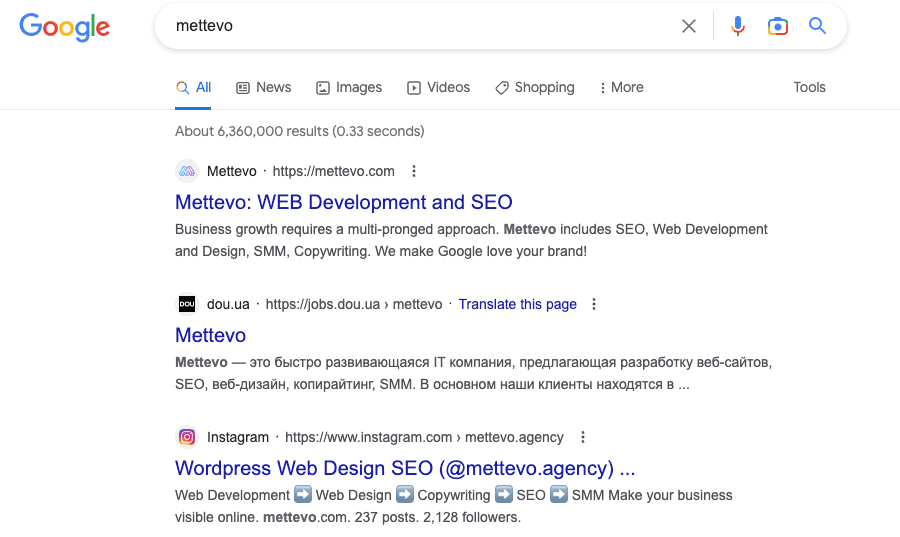
(The example of navigational search intent. Typing a branded search query “mettevo”, a user wants to navigate to the website of a digital marketing and web development agency “Mettevo”)
To make users search your website with navigational queries, you are to make sure that people are aware of your brand. Consequently, to achieve public awareness of your brand, you want to use all the marketing tools and channels – from content marketing to social media marketing. After you succeed in your brand creation, your website will rank for keywords with navigational search intent organically.
- Commercial search intent
Though while typing a commercial search query, a user has the same reason for searching in mind as in the case of informational intent – to seek specific information – they have differences in the kinds of searched information. Search intent becomes commercial when a user seeks information about a product or service before buying or leaving an order for some service. The most common markers of a commercial search intent may be the following keywords:
- That imply goods price: cheap/expensive (product name);
- That imply reviews and opinions: best (product name), (product name) reviews.
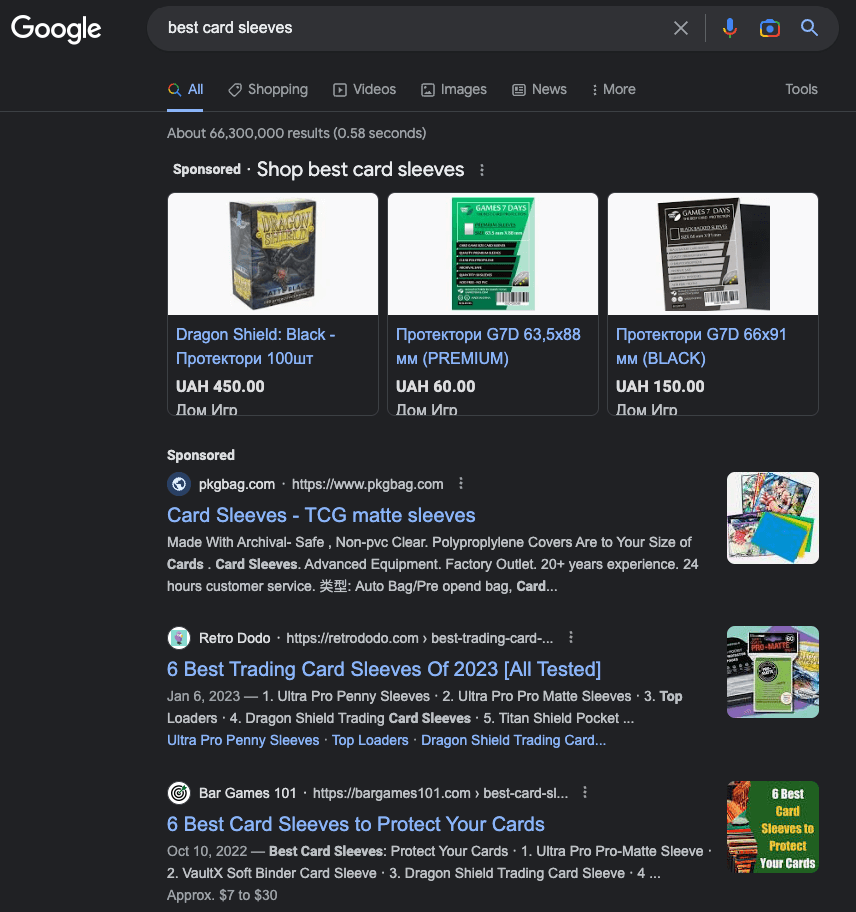
(The example of commercial search intent. Typing a search query “best card sleeves”, a user wants to find a piece of information about the product and make a decision on choosing the best one for buying)
The most usual result pages for commercial search queries are blog posts in the format of tops, listicles, and reviews. The distinctive feature of a page targeting a commercial query is the presence of affiliate and referral links to a product being reviewed.
- Transactional search intent
In the case of transactional search intent, a person is driven by a need to take some sort of action, to perform a transaction. The most common examples of transactions are:
- purchasing a specific product;
- signing up for some service;
- making a table reservation in a restaurant;
- to book a hotel room.
Therefore, a search query usually includes a product or service name, brand names, prices and words such as "buy," "order," "reserve," or "book".
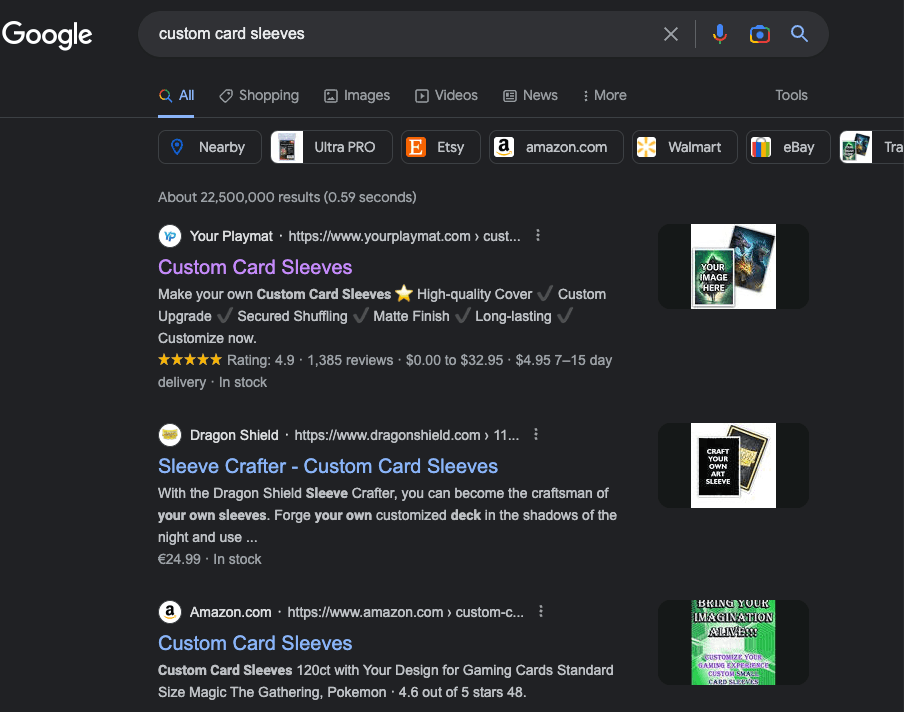
(The example of commercial search intent. Typing a branded search query “mettevo”, a user wants to navigate to the website of a digital marketing and web development agency “Mettevo”)
Obviously, pages of products or services are the results you will receive in SERP when executing a transactional search query.
- Local search intent
Users with local search intentions want to find information or services according to the geographic location of their choice. This type of search intent has the features of commercial and transactional intents дsince the user is either not sure about local business services and wants to learn more about local businesses OR the decision has already been made and he just wants to find relevant business locations on the map.

(The example of local search intent. Typing a search query “seo service in new york”, a user wants to find a physical location of an SEO agency in the city or to sort out agencies by geolocation)
Local search intent can be easily recognized via the presence of a map snippet in Google search results and the following keywords:
- That imply location: “near me”, “around (location)”, “in (city/area name)”;
- That imply direction: "how to get to (business name)," "directions to (location);
- That imply local reviews and ratings: “best (business/service) in (location)," "reviews of (business/service) in (location)," or "rated (business/service) in (location)";
- That imply businesses’ hours of work and contacts: "hours of (business/service) in (location)," or "phone number of (business/service) in (location)”.
Is it worth saying that any local business must have an online representation on Google maps (previously Google My Business) to scale the business?
- Personal search intent
Being quite close in search purpose to navigational search intent, a personal search intent, as it lies in the very word, is directly related to the personal data of a person executing a search query. A user wants to get access to personal information on a service he has been signed up for, usually with an authentication process to follow.
Thus, the distinctive feature of personal search intent is that queries come with the keyword “my” such as: “my parcel tracking”, “my Gmail account” etc.
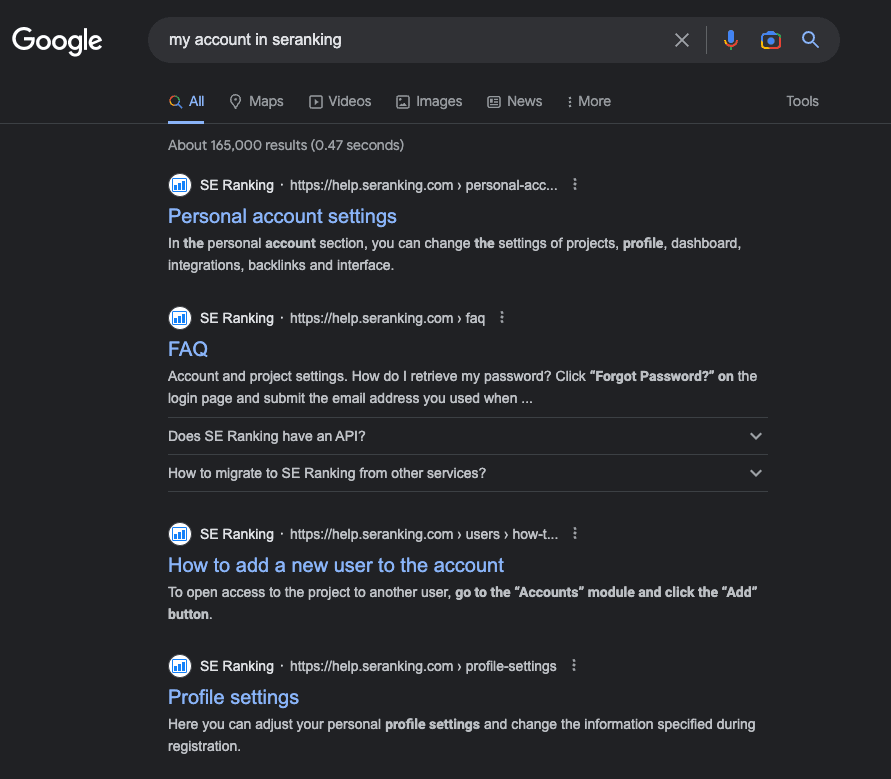
(The example of personal search intent. Typing a search query “my account in seranking”, a user wants to get to his SEranking account)
Personal search intent is a result of Google becoming person-oriented and therefore becoming more and more convenient for users to receive access to their data.
- Combined search intent
Since a user's search query may have multiple goals or objectives, in that case, we have a deal with so-called combined search intents. All the above-mentioned search intents may be combined in a user’s search query.
The distinctive markers of combined search intents:
- Combined informational and transactional search intent – let us say a user is searching for some information but also wants to purchase a product described in the material. Thus, the search intent would be a combination of informational intent and transactional intent.
*It’s important not to confuse a commercial intent with a combination of informational and transactional intents. The difference here is that in the case of combined search intent – a user wants to complete 2 tasks within a single search query, while, in the case of the transactional search query, a user has only 1 objective in mind – to compare prices and perform product research that may influence on his further transactional search intent.
Combined informational and transactional search intent often includes distinctive keywords of a commercial query as “the best” and the price range. For example “best laptops for work from home under $800” – the user wants to define the best laptop for working from home (informational search intent) and to buy it in the price range of $800 (transactional search intent).
- Combined local and transactional search intent – often includes words that imply a geographical location and features (contacts/accessibility/facilities) of a local business. For example “pizzeria with free hotspot that is currently open”. The user wants to find a pizzeria that is open (local search intent) and which shares wi-fi for free (informational intent).
- Combined personal and informational intent – is a long-tail form of personal search intent that include more precise data. For instance, “my (service name) account order history”. The user wants to sign in to his account (personal search intent) and get the information about his account’s order history (informational search intent).
Ways to identify and understand a keyword intent to pick the most relevant to a webpage
There are a few ways to identify the search intent behind a user's query. Let’s consider the most common ways that most SEOs use:
- Hints within keywords phrase

The words and phrases used in a search query can often provide clues about the search intent. For example, the structure of the query, and the use of questions, modifiers or prepositions, which can provide further clues about the user's intent. Also, consider the context in which a search is performed, as it can provide clues about the search intent. For example, a search performed on a mobile device is more likely to have local or navigational search intent.
- SERP analysis

Examining the search results for a particular query can also provide insights into the search intent. For example, if the top results are mostly informational articles, the search likely has informational search intent. If a search results page contains a map as a snippet, it is likely that you are dealing with a local user’s intent.
- SEO tools

There are several tools available that can help identify the search intent behind a query. The most usable amongst SEOs are:

SEMrush is likely the easiest way to receive data about a keyword’s intents as it has a powerful keyword research tool that can provide data about the intent behind a keyword based on search results in no time.
- Ahrefs

Ahrefs is another comprehensive tool that may help to identify and pick a keyword with the right intent, which a webpage requires. Unlike automated SEMrush response on keyword’s intent, Ahrefs just gives you data about top webpages for definite queries and other relevant information to a chosen keyword, so that you can find out the search intent behind a query on your own.
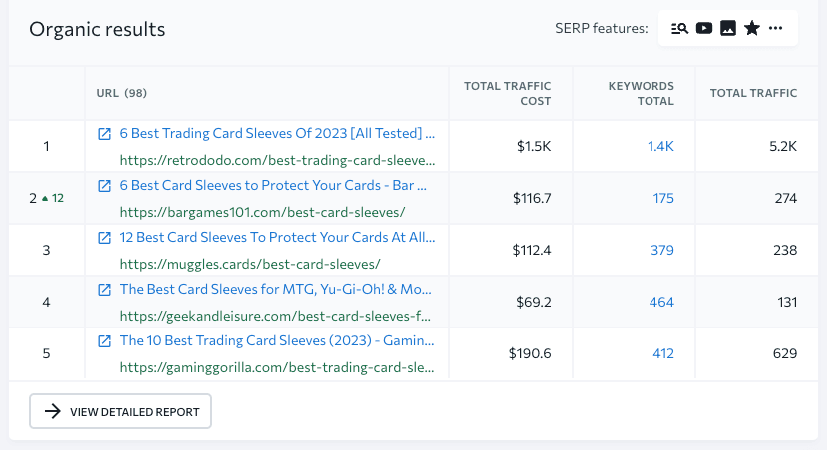
SEranking is a keyword research and SEO tool that can help you identify the intent behind a keyword. It can provide you with data on search volume, CPC, competition, and related keywords. By the analogy of Ahrefs, SEranking doesn’t offer automated keyword intent identification, just SERP data a user needs to analyze on his own to determine a keyword intent.
“Search intent” and “keyword intent”: Are these terms mean the same?
Though in some contexts these terms may seem interchangeable, they don’t mean the same thing. The “search intent” term can be considered a hypernym (a term with a broader meaning) of a “keyword intent” since the “search intent” refers to the overall goal of a user’s search query and a keyword intent is just one of the factors alongside user’s context and search history that are taken into account. Therefore a “keyword intent” is a hyponym (a term with a more specific meaning) of the term “search intent” which means a user’s objective behind a specific keyword. SEOs mostly are dealing with. Digital marketers which understand the difference between both terms are able to provide great results in the matter of search engine optimization, delivering a more relevant page experience matching user’s needs.
Summing up
In conclusion, search intent is the reason why a user conducts a specific search query. Understanding the intent behind a user's search query is crucial for improving SEO efforts.
There are several types of search intent, including informational, transactional, navigational, commercial, local and personal intent. By analyzing the search query, understanding the user's context, identifying the intent, picking the most relevant keyword, and using keyword research tools, you can improve your SEO and provide a better user experience.
Frequently asked questions
What is search intent?
What is keyword intent?
Why is search intent important for SEO?
What are the different types of search intent?
How do I identify the search intent behind a user's query?
How do I optimize for search intent?
learn with mettevo
view blogAre You Ready To Grow Your Website?
Understanding the ins and outs of website growth, we help ensure that your site grows over time with ever-increasing reach and accessibility. Not only do we employ the latest digital marketing techniques for driving traffic directly to your website, but our strategies also focus on gaining loyalty from those visitors so they come back again and again.
Leave your contacts to get a comprehensive and aggressive digital marketing plan taking your business to new heights.